I have a uilabel setup in a view. It doesn't have a width constraint, but its width is instead determined by a leading constraint to the thumbnail image, and a trailing constraint to the edge of the view.

The label is set to have 0 lines, and to word wrap. My understanding is that this should cause the frame of the uilabel to grow, and indeed it does sometimes. (Previous to auto layout, I would calculate and update the frame of the label in code).
So the result is, it works correctly in some instance and not others. See most cells working correctly there, but the last cell appears to be too big. In fact it's the right size. The title "Fair Oaks Smog Check Test" actually ends with "Only". So my calcuation for the cell size is right, it should be that size. However the label doesn't wrap the text for whatever reason. It's frame width does not extend off to the right, so that's not the issue.

So what is going on here? It's 100% consistent, always on that cell and not the ones above it, which makes me think it's related to the size of the text, and UILabel isn't re-laying out the text once this view is added to the cell (which makes it actually smaller width wise).
Any thoughts?
Some additional information
The height of the cells is calculated from one sample cell I create and store in a static variable:
- (CGFloat) tableView:(UITableView *)tableView heightForRowAtIndexPath:(NSIndexPath *)indexPath {
if (self.items.count == 0) {
return 60;
}
static TCAnswerBuilderCell *cell = nil;
static dispatch_once_t pred;
dispatch_once(&pred,
^{
// get a sample cellonce
cell = [tableView dequeueReusableCellWithIdentifier:TC_ANSWER_BUILDER_CELL];
});
[cell configureCellWithThirdPartyObject:self.items[indexPath.row]];
return [cell heightForCellWithTableWidth:self.tableView.frame.size.width];
}
I configure the cell with my data object on the fly, and then call a method I have on it which calculates the height of the cell with a given table width (can't always rely on the cell frame being correct initially).
This in turn calls a height method on my view, since it is really where the label lives:
- (CGFloat)heightForCellWithTableWidth:(CGFloat)tableWidth {
// subtract 38 from the constraint above
return [self.thirdPartyAnswerView heightForViewWithViewWidth:tableWidth - 38];
}
This method determines the height by figuring out the correct width of the label, and then doing a calculation:
- (CGFloat)heightForViewWithViewWidth:(CGFloat)viewWidth {
CGFloat widthForCalc = viewWidth - self.imageFrameLeadingSpaceConstraint.constant - self.thumbnailFrameWidthConstraint.constant - self.titleLabelLeadingSpaceConstraint.constant;
CGSize size = [self.titleLabel.text sizeWithFont:self.titleLabel.font constrainedToSize:CGSizeMake(widthForCalc, CGFLOAT_MAX) lineBreakMode:NSLineBreakByWordWrapping];
CGFloat returnHeight = self.frame.size.height - self.titleLabel.frame.size.height + size.height;
CGFloat height = returnHeight < self.frame.size.height ? self.frame.size.height : returnHeight;
return height;
}
This works 100% correctly.
The cells are created obviously in cellForRowAtIndexPath and immediately configured:
if (self.items.count > 0) {
TCAnswerBuilderCell *cell = [tableView dequeueReusableCellWithIdentifier:TC_ANSWER_BUILDER_CELL forIndexPath:indexPath];
[cell configureCellWithThirdPartyObject:self.items[indexPath.row]];
return cell;
}
In configuration of the cell, my view is loaded from a nib (it's re-used elsewhere, which is why it's not directly in the cell). The cell adds it as follows:
- (void) configureCellWithThirdPartyObject:(TCThirdPartyObject *)object {
self.detailDisclosureImageView.hidden = NO;
if (!self.thirdPartyAnswerView) {
self.thirdPartyAnswerView = [TCThirdPartyAPIHelper thirdPartyAnswerViewForThirdPartyAPIServiceType:object.thirdPartyAPIType];
self.thirdPartyAnswerView.translatesAutoresizingMaskIntoConstraints = NO;
[self.contentView addSubview:self.thirdPartyAnswerView];
[self.contentView addConstraints:[NSLayoutConstraint constraintsWithVisualFormat:@"|[_thirdPartyAnswerView]-38-|" options:NSLayoutFormatAlignAllCenterY metrics:nil views:NSDictionaryOfVariableBindings(_thirdPartyAnswerView)]];
}
[self.thirdPartyAnswerView configureViewForThirdPartyObject:object forViewStyle:TCThirdPartyAnswerViewStyleSearchCell];
}
Finally my view configuration looks like this:
- (void) configureViewForThirdPartyObject:(TCTPOPlace *)object forViewStyle:(TCThirdPartyAnswerViewStyle) style {
self.titleLabel.text = object.name;
self.addressLabel.text = [NSString stringWithFormat:@"%@, %@, %@", object.address, object.city, object.state];
self.ratingsLabel.text = [NSString stringWithFormat:@"%d Ratings", object.reviewCount];
NSString *ratingImageName = [NSString stringWithFormat:@"yelp_star_rating_%.1f.png", object.rating];
UIImage *ratingsImage = [UIImage imageNamed:ratingImageName];
if (ratingsImage) {
self.ratingImageView.image = ratingsImage;
}
if (object.imageUrl) {
[self.thumbnailImageView setImageWithURL:[NSURL URLWithString:object.imageUrl] completed:nil];
}
}
A sort of solution, but I don't understand why
- My subview was designed at 320 width, but has no constraints of its own for width
- The subview was added to the cell, but with horizontal constraints that look like this:
@"|[_thirdPartyAnswerView]-38-|"
- The view was configured immediately after being added to the cell, meaning the text for the titleLabel was set right then.
- For whatever reason, the text was laid out as if the view had the full 320 instead of 282.
- The label was never updated, even though the frame of the subview was updated to 282, and there were constraints on the label that would keep it sized correctly.
- Changing the size of the view in the xib to be 282 fixed the issue, because the label has the right size to begin with.
I'm still not understanding why the label doesn't re-lay out after the size of the parent view is updated when it has both leading and trailing constraints.
SOLVED
See Matt's answer below: https://stackoverflow.com/a/15514707/287403
In case you don't read the comment, the primary problem was that I was unknowingly setting preferredMaxLayoutWidth via IB when designing a view at a bigger width than it would be shown (in some cases). preferredMaxLayoutWidth is what is used to determine where the text wraps. So even though my view and titleLabel correctly resized, the preferredMaxLayoutWidth was still at the old value, and causing wrapping at unexpected points. Setting the titleLabel instead to it's automatic size (⌘= in IB), and updating the preferredMaxLayoutWidth dynamically in layoutSubviews before calling super was the key. Thanks Matt!